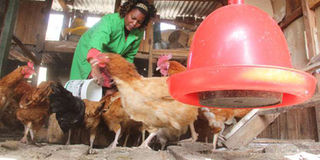Diary of a Poultry Farmer: My checklist to ward off those deadly diseases

A chicken farmer attends to her flock. Depleting the entire stock before bringing in new chicks helps because even otherwise healthy-looking birds could be carriers of diseases that then spread to the newly introduced birds. FILE PHOTO | NATION MEDIA GROUP
What you need to know:
- The “all-in, all-out” approach is about getting rid of all your stock to allow three months, which the chicken coop is cleaned, and disinfected to break the cycle of diseases.
- Structural measures are actions you need to undertake once and mainly relate to the physical design of the farm. Examples include having isolation pens for sick birds located away from resident birds or putting up foot baths at every entry point.
- Process measures are duties my worker undertakes frequently on daily, weekly or as need arises. For example, he needs to wear gloves, overall and footwear and remember to disinfect them at every point of entry daily, but I only expect him to disinfect the drinkers and feeders once a week.
When I had an outbreak of two lethal diseases a few weeks ago, one of the things that Dr Mugachia of Gardenvet recommended was for me to improve farm biosecurity (basic hygiene practices).
He visited for a third time (November 2) and, although I am still facing serious challenges with diseases, his report card was somehow encouraging.
“Hygiene practices have greatly improved and infection by mycoplasma is low grade,” he wrote. “I also noticed that Cleophas is happy to use the foot baths and keeps them filled with the foot disinfectant. He also appears to have accepted the use of gumboots every time he goes into the chicken rooms.”
Now, I shared my experiences on how to protect my farm from diseases and pests on October 29. They included the construction of footbaths, among other biosecurity measures
Mercy Mugure, a regular who devours this diary like a chicken pecking corn, picked up two recommendations that stood out. First, the “all-in, all-out” management approach and second, the farm biosecurity checklist.
“I had assumed that everyone who grew up upcountry should know something about farming,” she wrote, “But after reading your article, I realised my foolishness in assuming that anyone riding in a car can drive one.”
I giggled at the crispness of her analogy and marvelled at her attention to detail. I will address her two recommendations.
I told Mercy that as a matter of fact, the “all-in, all-out” approach is about getting rid of all your stock to allow three months, which the chicken coop is cleaned, and disinfected to break the cycle of disease. She was least convinced.
“Look,” she retorted, “In my case, I administered appropriate treatment as the vet had recommended and all the birds seemed to have recovered.” I understood why she didn’t see the point of getting rid of the entire stock and waiting for another three months before she could bring in new chicks because I am also struggling with that.
But I have come to learn from the vets that, “depleting the entire stock before bringing in new chicks helps because even otherwise healthy-looking birds could be carriers of disease that then spread to the newly introduced birds”.
PROCESS AND STRUCTURAL MEASURES
I have further learnt from the experts that sick birds tend to shed disease-causing organisms that can hide in the environment – walls, floors, clothing and ceilings for hours, days and even months.
I have also done research and found that some disease-causing organisms like mycoplasma and infectious coryza that have given me trouble (Seeds of Gold, August 27) in the past can survive in the environment for hours to days, while others like coccidiosis are more fastidious and can linger on for months.
At that point, she questioned the practicality of the strategy. I partially agreed with her because this strategy seems impractical.
“In that case, I would maintain a separate pen to isolate and quarantine all new, in-coming birds from the resident population,” I said. “I would also ensure that the isolation pens are as far away as possible from the resident birds and allow at least four weeks of quarantine period.”
When I realised we were getting somewhere with Mercy, I turned to the farm biosecurity checklist that she had requested. “Checklists are planning tools that act as reminders and they are even used by pilots, doctors and for planning to-do-tasks in the office.”
Now, to develop my checklist, I divided the farm biosecurity measures into ‘process’ and ‘structural’. Structural measures are actions you need to undertake once and mainly relate to the physical design of the farm. Examples include having isolation pens for sick birds located away from resident birds or putting up foot baths at every entry point.
The distinction between one-off and daily chores is important.
Process measures are duties my worker undertakes frequently on daily, weekly or as need arises. For example, he needs to wear gloves, overall and footwear and remember to disinfect them at every point of entry daily, but I only expect him to disinfect the drinkers and feeders once a week.
I have laminated and shared the checklist with Cleophas, the farm manager. Of course I don’t expect him to start implementing the ideas right away.
So, I have given him some time to try and unlearn some of his previous habits that I am partially to blame for because in the first place, I didn’t put up controls systems.
However, I also expect him to tell me which items on the list he thinks are “low lying fruits” that he can start implementing right away. My desire is that within three months, he will be implementing all 21 listed items.





